At the seventh annual National Immigrant Integration Conference earlier this month, USCIS Director Leon Rodriguez and L.A. Mayor Eric Garcetti stood before hundreds of immigration advocates, legal service providers and the staffs of city, state and federal government agencies. Just before Director Rodriguez’s speech, the mayor leaned over to him, gestured to the tables of conference participants and said, “This is your army.”
Indeed, among the executive actions announced by President Obama in November, the newly created Deferred Action for Parental Accountability, or DAPA, program will require legions to assist in the implementation of the program by providing information, outreach and direct services to immigrants who may qualify. The existing smaller Deferred Action for Childhood Arrivals program for unauthorized immigrants who arrived in the United States before age 15, which has also been expanded through executive action, serves as a gauge of what may transpire.
DAPA provides deportation relief and work authorization for undocumented U.S. residents who are parents of either U.S. citizens or legal permanent residents, and who entered the United States before January 2010 and have lived here continuously for at least five years, among other conditions. Gathering evidence to demonstrate life anchored in the United States may be the most challenging part of the program for those who arrived as adults. Unlike their DACA counterparts, the majority of these immigrants will not be able to rely on their own school enrollment records.
While estimates suggest close to four million immigrants may be eligible for the program, we know little about how many will come forward to apply, nor do we know much about their characteristics.
There are some clues from the DACA program that can help service providers and advocates anticipate who will need their outreach and services most.
At the start of DACA, many people who had their paperwork in order were motivated to come forward as soon as the program was implemented. Others were eligible but needed time to get documentation together, and there were those who needed to enroll in educational programs to qualify. Still others were reluctant to come forward given perceived risks. Applications tapered to a now steady but much smaller number.
Notably several groups have lower than expected application rates: those with roots in Asia and older male applicants. Data released by USCIS on age and gender of DACA applicants, a more youthful group of immigrants, reveal that overall, slightly more women requested DACA than men. But gender trends diverge by age: teenage applicants are slightly more likely to be male, but as age increases, so does the female share; those 30 and older are 58 percent female.
Will these trends repeat for the DAPA population, or will others emerge? Parents who are unauthorized immigrants with children legally in the United States are likely in a more precarious situation than those mostly youthful, mostly childless applicants who were granted DACA.
As one service provider I know put the risk, “[Applying for DAPA is] a matter of losing everything, not just an opportunity to get a work permit.”


Commentary
Who Are the DAPA-Eligible Population?
December 29, 2014